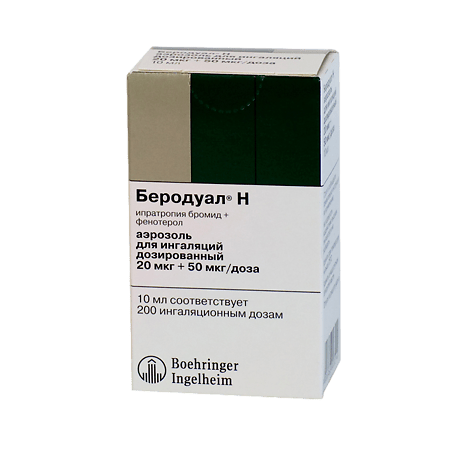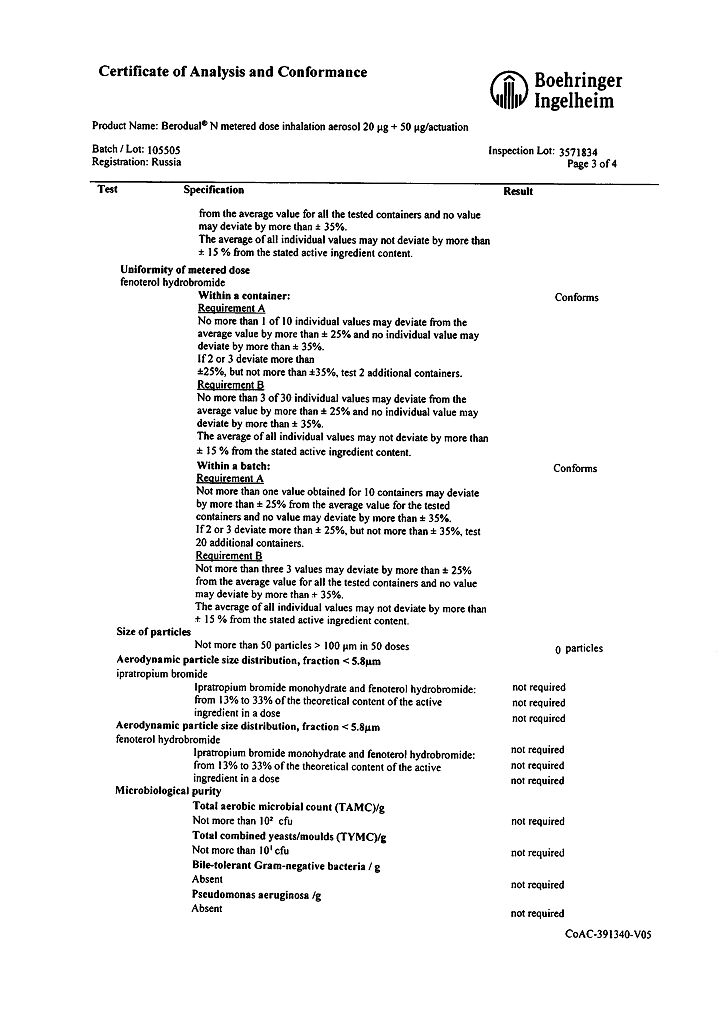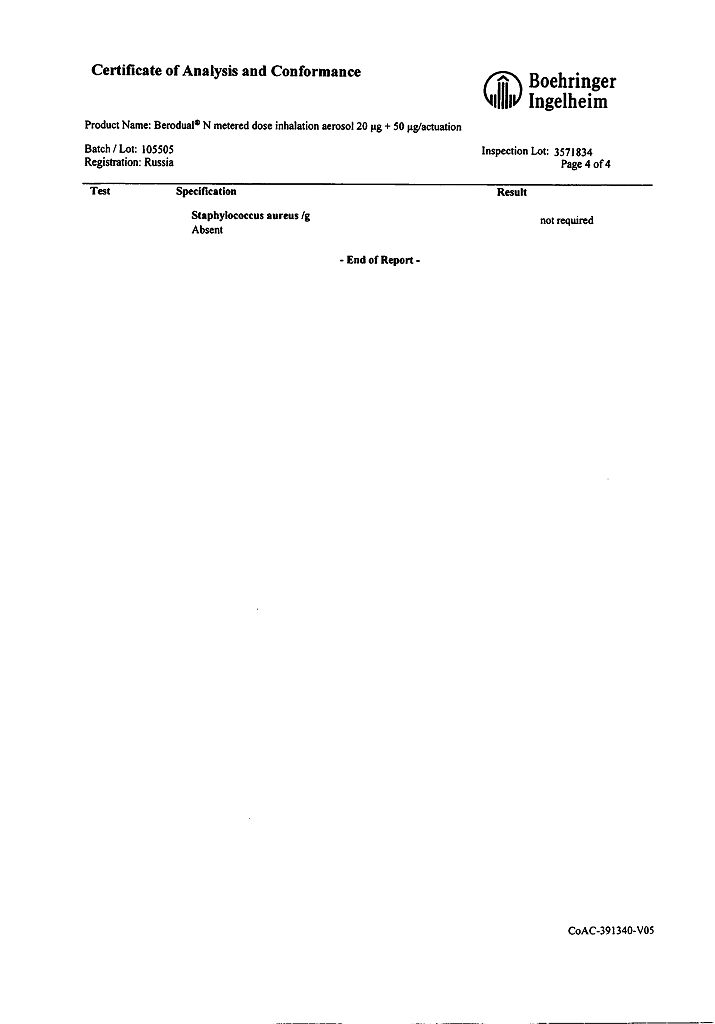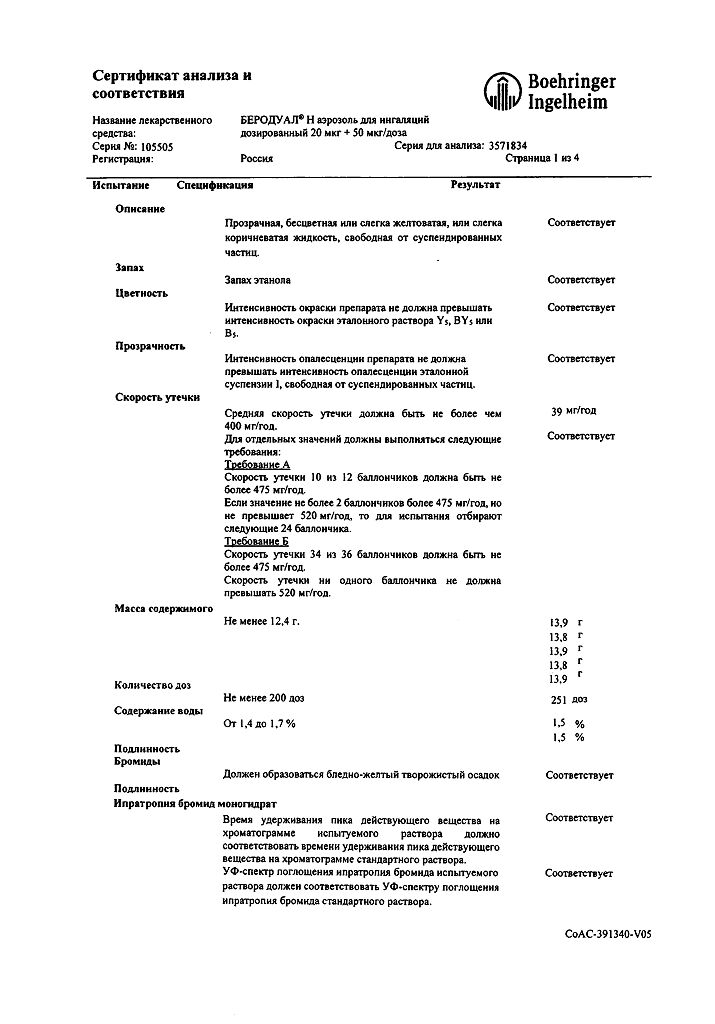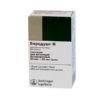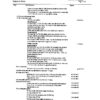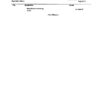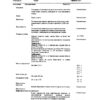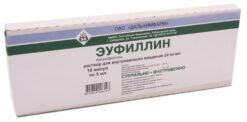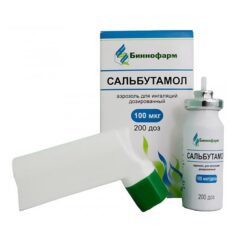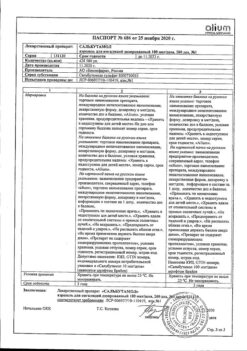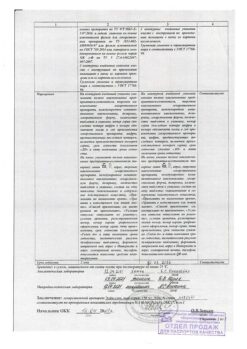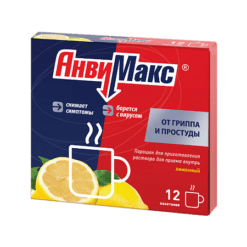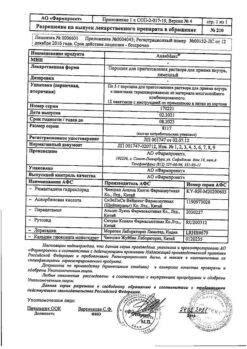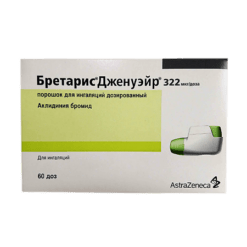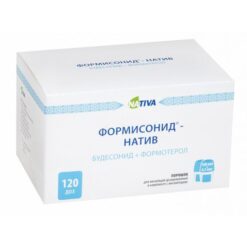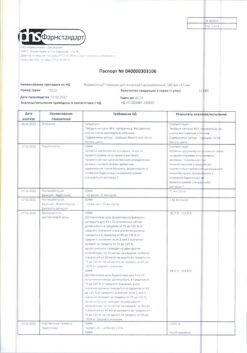No products in the cart.
Berodual N, aerosol 20 mcg+50 mcg/dose 200 doses
€13.13 €12.40
Description
Contains two components of the combined bronchodilator with bronchodilator activity: ipratropium bromide – m-cholinoblocker, and fenoterol hydrobromide – beta2-adrenomimetic.
In inhaled use of ipratropium bromide bronchodilatation is mainly due to local rather than systemic anticholinergic action. Ipratropium bromide is a quaternary ammonium compound. It has anticholinergic (parasympatholytic) properties.
Ipratropium inhibits reflexes mediated by the vagus nerve by counteracting the effects of acetylcholine, a neurotransmitter released from nerve endings. Anticholinergic agents prevent an increase in intracellular concentration of cyclic guanosine monophosphate (cGMP) in bronchial smooth muscle that occurs during the interaction of acetylcholine with m-cholinoreceptors.
The significant improvement of pulmonary function (increase of BEF1 and mean forced expiratory volume rate by 15% and more) in COPD patients with bronchospasm attacks comes within 15 min, the maximal effect is reached within 1-2 hours and lasts in the majority of patients till 6 hours after the injection. In 40% of patients with bronchospasm associated with bronchial asthma a significant improvement in pulmonary function (increase in SPR1 by 15% or more) is noted.
Ipratropium bromide has no negative effect on airway mucus secretion, mucociliary clearance and gas exchange. Fenoterol hydrobromide has a direct sympathomimetic effect. In therapeutic doses, it selectively stimulates β2-adrenoreceptors of the bronchi. At higher doses, it has the ability to stimulate β1-adrenoreceptors. Binding to β2-adrenoceptors activates adenylate cyclase with participation of stimulating Gs-protein.
Elevated levels of cyclic AMP activate protein kinase A, which then phosphorylates target proteins in smooth muscle cells. This, in turn, leads to phosphorylation of the light chain of myosin kinase, inhibition of phosphoinositide hydrolysis and opening of calcium-activated potassium channels. Fenoterol relaxes smooth muscles of bronchi and vessels and counteracts the development of bronchospastic reactions caused by histamine, methacholine, cold air and allergens (immediate-type hypersensitivity reactions).
Fenoterol blocks the release of bronchoconstrictor mediators of inflammation from mast cells immediately after administration. Use of fenoterol in higher doses increases mucociliary clearance.
Higher plasma concentrations of fenoterol inhibit uterine contractility. In addition, metabolic effects are observed when used in high doses: lipolysis, glycogenolysis, hyperglycemia and hypokalemia. Hypokalemia is mainly due to increased incorporation of potassium ions into skeletal muscle.
The beta-adrenergic effects of the drug on cardiac activity, such as increased HR and heart force, are due to the vascular action of fenoterol, stimulation of β2-adrenoreceptors of the heart, and when used in doses greater than therapeutic, stimulation of β1-adrenoreceptors. As with other beta-adrenergic drugs, prolongation of the QTc interval was observed when used in high doses.
The most frequently observed adverse effect of β2-adrenoreceptor stimulators is tremor. In contrast to the effects on bronchial smooth muscles, tolerance may develop to the systemic effects of β2-adrenoreceptor stimulators. Fenoterol prevents bronchoconstriction caused by various stimuli, such as physical activity, cold air and allergens (immediate-type hypersensitivity reactions).
When ipratropium bromide and fenoterol are used together, the bronchodilator effect is achieved by affecting different pharmacological targets. The mentioned substances complement each other, and as a result the bronchodilator effect increases and provides greater latitude of therapeutic action in bronchopulmonary diseases accompanied with airway constriction.
The complementary action is such that a lower dose of the beta-adrenergic component is required to achieve the desired effect, which facilitates individual dosing of the drug and helps minimize side effects.
Indications
Indications
Prevention and treatment of obstructive respiratory diseases with reversible bronchospasm: Chronic bronchitis, complicated or not complicated by emphysema. COPD Bronchial asthma.
Pharmacological effect
Pharmacological effect
Contains two components of a combined bronchodilator drug with bronchodilator activity: ipratropium bromide – an m-anticholinergic blocker, and fenoterol hydrobromide – a beta2-adrenergic agonist.
With inhaled ipratropium bromide, bronchodilation is due primarily to local rather than systemic anticholinergic effects. Ipratropium bromide is a quaternary ammonium compound. It has anticholinergic (parasympatholytic) properties.
Ipratropium inhibits reflexes mediated by the vagus nerve by counteracting the effect of acetylcholine, a neurotransmitter released from nerve endings. Anticholinergics prevent the increase in intracellular concentrations of cyclic guanosine monophosphate (cGMP) in bronchial smooth muscle that occurs when acetylcholine interacts with m-cholinergic receptors.
A significant improvement in lung function (increase in FEV1 and average forced expiratory volume flow rate by 15% or more) in patients with COPD with bronchospasm attacks occurs within 15 minutes, the maximum effect is achieved after 1-2 hours and lasts in most patients up to 6 hours after administration. In 40% of patients with bronchospasm associated with bronchial asthma, there is a significant improvement in lung function (an increase in FEV1 of 15% or more).
Ipratropium bromide does not have a negative effect on mucus secretion in the respiratory tract, mucociliary clearance and gas exchange. Fenoterol hydrobromide has a direct sympathomimetic effect. In therapeutic doses, it selectively stimulates bronchial β2-adrenergic receptors. At higher doses, it has the ability to stimulate β1-adrenergic receptors. Binding to β2-adrenergic receptors activates adenylate cyclase with the participation of the stimulating Gs protein.
Elevated levels of cyclic AMP activate protein kinase A, which then phosphorylates target proteins in smooth muscle cells. This in turn leads to phosphorylation of myosin kinase light chain, inhibition of phosphoinositide hydrolysis, and opening of calcium-activated potassium channels. Fenoterol relaxes the smooth muscles of the bronchi and blood vessels and counteracts the development of bronchospastic reactions caused by the influence of histamine, methacholine, cold air and allergens (immediate hypersensitivity reactions).
Immediately after administration, fenoterol blocks the release of bronchoconstrictor inflammatory mediators from mast cells. The use of fenoterol in higher doses increases mucociliary clearance.
At higher plasma concentrations of fenoterol, uterine contractility is inhibited. In addition, when used in high doses, metabolic effects are observed: lipolysis, glycogenolysis, hyperglycemia and hypokalemia. Hypokalemia is caused mainly by increased incorporation of potassium ions into skeletal muscles.
The beta-adrenergic effect of the drug on cardiac activity, such as an increase in heart rate and strength of heart contractions, is due to the vascular effect of fenoterol, stimulation of β2-adrenergic receptors of the heart, and when used in doses exceeding therapeutic doses, stimulation of β1-adrenergic receptors. As with other beta-adrenergic drugs, prolongation of the QTc interval has been observed when used in high doses.
The most commonly observed adverse effect of β2-adrenergic stimulants is tremor. In contrast to the effects on bronchial smooth muscle, tolerance may develop to the systemic effects of β2-adrenergic receptor stimulants. Fenoterol prevents the development of bronchoconstriction caused by various stimuli, such as physical activity, cold air and allergens (immediate hypersensitivity reactions).
When ipratropium bromide and fenoterol are used together, the bronchodilator effect is achieved by acting on various pharmacological targets. These substances complement each other, as a result, the bronchodilator effect is enhanced and a greater breadth of therapeutic action is provided for bronchopulmonary diseases accompanied by constriction of the airways.
The complementary action is such that a lower dose of the beta-adrenergic component is required to achieve the desired effect, which facilitates individual dosing of the drug and helps minimize side effects.
Special instructions
Special instructions
In patients with a history of cystic fibrosis, gastrointestinal motility disorders may occur when using Berodual N. The advisability of concomitant anti-inflammatory therapy for COPD in patients in whom corticosteroids are effective and for bronchial asthma should be considered.
With long-term use in patients suffering from bronchial asthma or mild to moderate forms of COPD, symptomatic treatment may be preferable to regular use. With long-term use in patients with bronchial asthma or steroid-dependent forms of COPD, one should remember the need to carry out or intensify anti-inflammatory therapy to control the inflammatory process of the respiratory tract and the course of the disease.
Regular use of Berodual N in increasing doses to relieve bronchial obstruction can cause uncontrolled worsening of the disease. In case of increased bronchial obstruction, simply increasing the dose of Berodual N more than the recommended dose for a long time is not only not justified, but also dangerous.
To prevent life-threatening worsening of the disease, consideration should be given to reviewing the patient’s treatment plan and adequate anti-inflammatory therapy with inhaled corticosteroids. The patient should be informed that in case of sudden development and rapid progression of shortness of breath, it is necessary to consult a doctor.
Other sympathomimetic bronchodilators should be prescribed simultaneously with Berodual N only under medical supervision. The patient should be informed about the rules for using the inhaler. Eye pain, blurred vision, the sensation of a halo or colored spots in front of the eyes, combined with redness of the eye in the form of a conjunctival or corneal injection, may be signs of an acute attack of angle-closure glaucoma.
If the listed symptoms appear in any combination, the patient should begin treatment with eye drops that cause pupil constriction and immediately seek specialized medical help.
Active ingredient
Active ingredient
Ipratropium bromide, Fenoterol
Composition
Composition
1 dose contains:
active ingredients:
fenoterol hydrobromide 50 mcg;
ipratropium bromide monohydrate 21 mcg, which corresponds to the content of ipratropium bromide 20 mcg.
excipients:
absolute ethanol,
purified water,
citric acid,
tetrafluoroethane (HFA 134a, propellant).
Pregnancy
Pregnancy
Contraindicated in the first trimester of pregnancy. Current experience has shown that ipratropium bromide and fenoterol hydrobromide do not have adverse effects during pregnancy.
However, in the second and third trimesters of pregnancy, Berodual®N should be used with caution. It is necessary to take into account the possibility of an inhibitory effect of Berodual N on the contractile activity of the uterus. Fenoterol hydrobromide is excreted in breast milk. There is no data confirming the excretion of ipratropium bromide in breast milk.
Significant exposure of an infant to ipratropium, especially when administered as an aerosol, is unlikely. However, given the ability of many medications to pass into breast milk.
Berodual®N should be prescribed with caution during lactation (breastfeeding).
Contraindications
Contraindications
Children’s age up to 6 years. I trimester of pregnancy. Hypertrophic obstructive cardiomyopathy. Tachyarrhythmia. Hypersensitivity to the components of the drug.
Hypersensitivity to atropine-like substances.
With caution: use the drug for angle-closure glaucoma, coronary insufficiency, arterial hypertension, poorly controlled diabetes mellitus, recent myocardial infarction, severe organic diseases of the cardiovascular system, hyperthyroidism, pheochromocytoma, prostatic hypertrophy, bladder neck obstruction, cystic fibrosis, in children over 6 years of age.
Side Effects
Side Effects
Allergic reactions: rarely – skin rash, angioedema of the tongue, lips, face, urticaria, laryngospasm, laryngeal edema, anaphylactic shock.
From the side of the central nervous system: often – slight tremor of skeletal muscles, nervousness; sometimes – headache, dizziness (especially in patients with aggravating factors); in isolated cases – mental changes.
From the cardiovascular system: sometimes – tachycardia, palpitations (especially in patients with risk factors); rarely (when used in high doses) – decreased diastolic blood pressure, increased systolic blood pressure, arrhythmia, fibrillation, supraventricular tachycardia.
From the side of water and electrolyte balance: sometimes – severe hypokalemia.
From the respiratory system: sometimes – cough, local irritation (pharyngitis); rarely – paradoxical bronchospasm.
From the organ of vision: rarely – reversible disturbance of accommodation, mydriasis, increased intraocular pressure, angle-closure glaucoma, pain in the eyeball.
Other: possible increased sweating, weakness, myalgia, convulsions; rarely – reversible urinary retention.
From the digestive system: often – dry mouth; sometimes – nausea, vomiting; rarely – reversible gastrointestinal motility disorders (constipation, diarrhea).
Interaction
Interaction
Beta-adrenergic agonists and anticholinergics, xanthine derivatives (including theophylline) can enhance the bronchodilator effect of Berodual N.
Inhalation anesthetics containing halogenated hydrocarbons (including halothane, trichlorethylene, enflurane) can enhance the effect of Berodual N on the cardiovascular system.
With the simultaneous use of other beta-agonists, anticholinergics entering the systemic circulation or xanthine derivatives (including theophylline), side effects may increase. A significant weakening of the bronchodilator effect of Berodual N is possible with the simultaneous administration of beta-blockers.
When used simultaneously with MAO inhibitors and tricyclic antidepressants, an increase in the effect of Berodual N is observed. With the use of Berodual N, hypokalemia may develop, which may increase when administered simultaneously with xanthine derivatives, corticosteroids and diuretics.
This fact should be taken into account when treating patients with severe forms of obstructive airway diseases. Hypokalemia increases the risk of developing arrhythmias in patients receiving digoxin. In addition, with hypoxia, the negative effect of hypokalemia on heart rate increases. In such cases, it is recommended to monitor serum potassium levels.
Overdose
Overdose
Symptoms: fenoterol hydrobromide and are caused by excessive stimulation of β-adrenergic receptors: tachycardia, palpitations, tremor, arterial hypo- or hypertension, increased pulse blood pressure, angina pectoris, arrhythmia, hot flashes and symptoms of ipratropium bromide overdose: dry mouth, impaired accommodation – due to the wide breadth of therapeutic action and inhalation use, as a rule, are little expressed and have a transient nature.
Treatment: prescription of tranquilizers, sedatives. If necessary, intensive therapy. As a specific antidote, it is possible to use beta-blockers, preferably selective beta1-blockers. However, one should be aware of the possible increase in bronchial obstruction under the influence of beta-blockers and carefully select the dose for patients suffering from bronchial asthma or COPD due to the risk of severe bronchospasm, which can be fatal.
Storage conditions
Storage conditions
Store out of the reach of children at a temperature not exceeding 25°C.
Shelf life
Shelf life
3 years
Manufacturer
Manufacturer
Boehringer Ingelheim Pharma GmbH & Co.KG, Germany
Additional information
| Shelf life | 3 years |
|---|---|
| Conditions of storage | Keep out of the reach of children at temperatures under 25°C. |
| Manufacturer | Boehringer Ingelheim Pharma GmbH & Co. |
| Medication form | inhalation aerosol |
| Brand | #Н/Д |
Related products
Buy Berodual N, aerosol 20 mcg+50 mcg/dose 200 doses with delivery to USA, UK, Europe and over 120 other countries.

